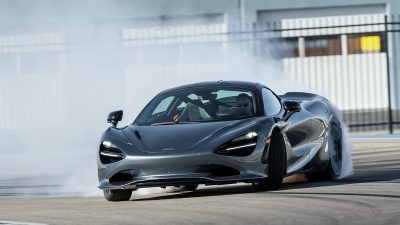This year marks the 74th anniversary of the founding of Formula 1, the motorsport championship, and James Allen has covered more than 30 seasons as a journalist, broadcaster and industry insider. In doing so, he has watched the Maranello team endure extreme days and humiliations, while also witnessing the game’s recent rise in popularity in the global consciousness.
A graduate of Oxford University and now CEO of Motorsport Network, Alan inherited his love of racing from his father, who was a Lotus factory driver and winner of the 1961 24 Hours of Le Mans.
“As a child, I began to understand the mentality of the people who drove cars, ran race teams and organized championships,” says Allen. “But despite my love of racing,” It was always clear to me that storytelling was my forte,” says the author of books on Formula One racing greats Nigel Mansell and Michael Schumacher.
Allen recently spoke to Robb Report about his latest work, “Ferrari: Inside and Out”, a nearly 300-page coffee table book released last May. Here he also shares his thoughts on past champions who have fueled the sport’s recent surge, and the current 2024 season – a 24-race stretch in which Ferrari finds itself second in the Constructors’ Championship heading into the Australian Grand Prix Is. award. Next weekend. he looks
Is there a period that you consider to be the golden age of Formula 1?
I would say that I am not alone. Senna, Prost, Mansell; These people were real warriors. They did not arrest anyone. He was very intolerant of machines because he was very determined and dedicated to his work. But at the same time, the cars were a lot safer than in my dad’s racing days, when you didn’t want to get too close to each other or get into an accident because you could die. [The cars] are still not completely safe, as the crashes of [Ayrton] Senna and Roland Ratzenberger on the same weekend in 1994 showed us. But still, [drivers] could play a high-speed game of chicken with each other. It was incredibly exciting and created a real wave of excitement around Formula 1.
And then I would say the second [period] was in the early 2000s. Apart from the two seasons dominated by Schumacher in 2002 and 2004, the championship at that time was very exciting, with very dedicated people trying to reach the level of Schumacher and Ferrari.
Were you close to any drivers during that period?
I got to know Sin well and talked to him a lot. I cherish these memories. He was certainly a unique and wonderful person. I wrote two books with Michael Schumacher and at that time I had exclusive access to Ferrari and was able to see what the winning car looked like.
What factors contributed to the transformation of Formula 1 from a European-oriented sport to one that enjoys immense global popularity?
Until recently, 60% of viewers lived in Europe, but the situation has changed over the years. When it was run by Bernie Ecclestone, he sought to establish several new races in Asia in the late 1990s and early 2000s. Then, in 2017, Liberty Media took over and realized that Bernie’s weakness was that he had never been successful in America. [Liberty Media] had a set of tools to do that. He relaxed the rights of drivers and teams to use social media and video on the track – all kinds of things that Bernie wouldn’t allow because he didn’t understand the digital revolution and Liberty did. They pulled all the right strings and Drive to Survive was a clear hit.
The second thing is cost control, which is still in its infancy. The weakness of Formula 1 has always been the lack of proper financial regulation. Big teams can always run away and spend as much as they want to maintain their lead. However, over the next few years, you will see this area becoming more closed. Not only will Formula 1 look amazing and feature tons of great characters, but it will also be an incredibly competitive race.
When and how did the idea for the book “Ferrari: Inside and Out” come about?
I’m the chairman of Motorsport Network, which is now just a media company, but a few years ago it had some other properties, one of which was a very large image library called Motorsport Images. It housed the collections of Rainer Schlegelmilch and Ercole Colombo, two absolutely famous photographers who, fortunately, are still with us today despite their retirement. The owner of the collection said he would like to do something involving these two, but left it up to me to decide what exactly.
I met him and he felt this project should be about Ferrari because Ercole Enzo was Ferrari’s photographer and he had incredible access to amazing behind-the-scenes photos. Reiner certainly considered himself a shy outsider and belonged to the magnum school of reportage. So it was a Ferrari inside and out.
How much access did Ferrari give you to the project?
Everyone was very happy to take part: from Piero Ferrari and Luca di Montezemolo to Stefano Domenicali and Jean Todt and even Mauro Forghieri shortly before his death. They were all happy to contribute and contributed generously. I am very grateful for his time and understanding.
What is the production time of the book?
About 18 months. Of course, this is helped by the fact that it’s only about 15,000 words long.
What intangible assets make Ferrari the winningest team in Formula 1 history?
Team Success in business always depends on people. This is true for any team, be it Red Bull today, Mercedes five years ago or Ferrari in the era of Schumacher and Todt. The key is strong leadership. When Ferrari succeeded, it was despite politics as they had a more complex political structure around them than any other Formula 1 team. Until about five years ago, the Italian media had tremendous power. But Todd defended the team. You can see the peace of the drivers, mechanics and technicians who were able to continue their work without media provocation.
Besides Enzo, who had the biggest influence on Ferrari?
Without a doubt it would be Luca di Montezemolo. In the late 1970s, Enzo Ferrari appointed Montezemolo, then about 20 years old, as team manager. He eventually moved on to other things within the Fiat empire, but came back again [in 1991] and established not only the road team, but also the organization of the Formula 1 team. He was the one who hired Todt and eventually Schumacher. Montezemolo created the environment that led to Ferrari’s success in the late 1990s and early 2000s. He is the most important person at Ferrari since Enzo.
In your opinion, does the current Ferrari Formula 1 team have the potential to repeat past glories?
It is difficult to answer this question. They have resources. I think they have a very good and strong leader in Fred Vasser, who knows what it takes to be successful in motorsport. And they have two drivers in Leclerc and Sainz who can rival the best in Formula 1. But he has a lot of politics to deal with. It is really about maintaining stability within the team and protecting it from outside forces, which is always the key to success.
You’ve written books about both Nigel Mansell and Michael Schumacher. What do you find in common between the Formula 1 champions?
What sets them apart is their commitment. These were two particularly dedicated people, and Cena was the most dedicated person I have ever met. Most of the great champions – whether it’s Verstappen, Hamilton, Schumacher, Mansell – their dedication is incredible. And with that comes an amazing work ethic. [Mansell and Schumacher] were relentless in their demands on the team, chasing every small advantage. He made every possible effort to overcome the resistance. There is a constant pursuit of self-improvement. Whether you are a driver, engineer or team leader, you cannot stand still, you must continuously improve.










